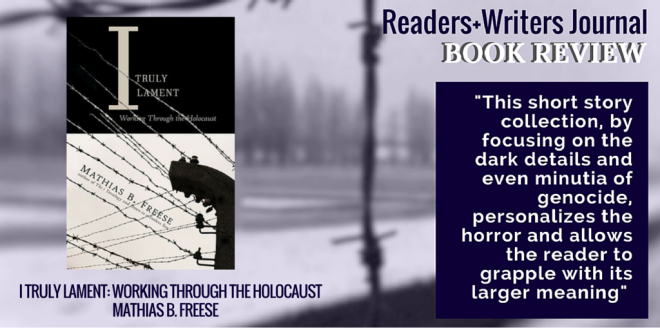I Truly Lament: Working Through the Holocaust by Mathias B. Freese
Is there a book big enough to elucidate or explain genocide on a mass scale? We can read about facts and figures, but the human toll is impossible to take in all at once. If there is any way to understand the mass murder of millions of human beings, it is in small doses or glimpses of the horror from the viewpoint of individuals. Snapshots of genocide, rather than great, over-arching tomes that seek to explain the inexplicable. The most effective works of art about the subject of the holocaust, in which an estimated 11 million people were put to death, have been movies like Louis Malle’s Au Revoir Les Enfants, and books like Primo Levi’s Survival in Auschwitz, which tell an individual story about the holocaust’s impact on one person. I Truly Lament, by focusing on the dark details and even minutia of genocide, personalizes the horror and allows the reader to grapple with its larger meaning and with the meaning of subsequent holocausts and genocides.
I Truly Lament: Working Through the Holocaust, by Mathias B. Freese is a collection of 27 short stories that seeks to shed light on the holocaust by showing it from various angles. In the preface, the author writes, “All literary depictions of the Holocaust end as failures, perhaps revealing shards of understanding,” and Freese has written a collection of “shards” that are often horrifying, sometimes amusing and always fascinating. From the story of a man trying to escape the Nazis who enlists the help of a world-weary golem, to a dialogue about food between a concentration camp survivor and his rescuer to an interview with Eva Braun, Freese has written a collection that shows his own struggle for understanding, and that helps anyone with the fortitude to withstand some of the gory details to understand as well. Even the “lighter” stories, about holocaust deniers and about Hitler memorabilia collectors, are infused with a great sense of sadness and even incredulity. Almost as though the author himself cannot quite believe what he is writing.
There are no silver linings or maudlin messages about hope in the midst of despair in this collection, and reading some is truly like staring into an abyss of cruelty and inhuman behavior. Freese’s stories, written from varying points of view and in varying styles, from magical realism to quasi-gothic, are often reminiscent of Jerzy Kosinski’s The Painted Bird, with its grotesque descriptions of senseless violence. Each focuses on Jewish victims and the unique impact of the holocaust on Jews, and each is the work of a talented writer who freely admits that he is obsessed with examining the holocaust and wrestling with its meaning. These stories do just that, and it seems fitting that stories about a subject as complicated and dark and difficult as the murder of 11 million people and the attempted genocide of an entire culture should themselves be complicated and dark and difficult.

Leave a Reply